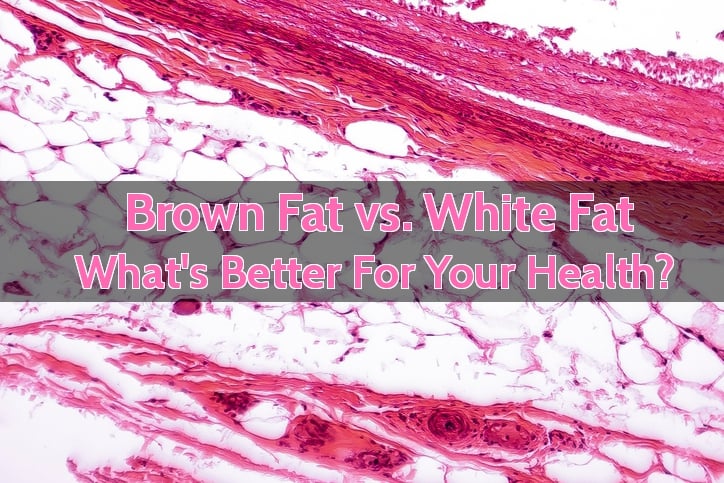Brown Fat vs. White Fat: What’s the Difference and Why it Matters?

Brown fat has emerged as one of the most attractive tools for burning body fat, also referred to as “white fat”. But what the heck is brown fat? And where can you find this unique type of fat? How does it help burn unwanted fat? What else can this wonder fat do? We’ll answer these questions and more as we dive into a discussion of brown fat vs. white fat.
Brown Fat: Turning Up the Heat
For starters, brown fat, also called brown adipose tissue (or, BAT for short), is actually a type of body fat. But it is markedly different from unwanted body fat, which is also called white adipose tissue (WAT). When comparing brown fat vs. white fat, the most important thing to point out is that they serve significantly different functions.
Unlike white fat, which is essentially a storage depot for extra calories, brown fat functions as a metabolically active thermogenic tissue. This means it is designed to generate heat and help regulate body temperature. Simply put, when it comes to brown fat vs. white fat, BAT dissipates energy whereas WAT stores energy.
Along these lines, it was long believed that brown fat was found only in small mammals, hibernating animals, and human infants. For instance, brown fat is necessary for newborn babies to cope with the thermal shock of delivery. Basically, brown fat is designed to help small mammals keep body temperature constant in cold temperatures without shivering (called non-shivering thermogenesis).
For years, the scientific community believed brown fat was negligible, if not nonexistent, in adult humans. However, in 2009, a series of seminal studies unequivocally proved this belief was false. Brown fat is, in fact, present and metabolically active in healthy adults and is predominantly located in the neck and upper back (between the shoulder blades).
Brown Fat vs. White Fat
Okay, so you know BAT can help keep you warm, but what else is different between brown fat vs. white fat? In other words, what can brown do for you? In addition to their specific functions, WAT contains only a few mitochondria, which are often referred to as cellular “power plants” because they are responsible for burning fat and carbs to provide energy. In fact, mitochondria produce about 95% of the body’s energy.
On the other hand, brown fat is loaded with mitochondria (i.e., energy-producing power plants). And unlike white fat, BAT is highly vascularized and innervated. In other words, another key difference between brown fat vs. white fat is that BAT gets plenty of blood flow and can easily be activated by the (sympathetic) nervous system.
At this point, let’s summarize the functions of BAT including what separates brown fat vs. white fat:
- Brown fat is a metabolically active thermogenic tissue. That means brown fat burns energy to maintain body temperature.
- Peeling back the onion another layer, brown fat burns carbs and fats (including stored body fat) to produce heat.
In other words, brown fat is one of your best friends if you’re interested in…
- Boosting your metabolism.
- Burning more fat.
- Improving glycemic control and insulin sensitivity.
Since that list pretty much garners the attention and interest of every human, let’s explore some more questions regarding brown fat.
How do you “turn on” BAT? Considering the primary role of brown fat is to generate heat to maintain body temperature, I’ll give you one guess as to the number one factor that can activate BAT. If you said COLD exposure, then you’d be right on the money. The good news is you don’t need to move to the North Pole or skinny dip in a freezing-cold pool—although those would probably work.
Recent studies have shown that exposure to temperatures ranging from 10 – 17°C (50 – 62°F) for 2 – 6 hours per day for 10 days to 4 weeks can dramatically (45 – 65%) boost activity of brown fat. Not surprisingly, these short-term cold acclimation studies have also led to significant reductions in WAT—you know, that unwanted type of body fat.
Does every adult have brown fat? As exciting as all this talk about BAT is, the unfortunate news is that the metabolism-boosting, fat-burning engine that is brown fat may be harder to recruit in certain people. For instance, older, obese, and/or type 2 diabetic folks seem to have much lower brown fat activity compared to leaner, healthier folks.
Is there any way to increase brown fat? This is a very good question that researchers are actively investigating given the potential of BAT to reduce body fat and improve metabolic health. Along these lines, there’s evidence it may be possible to “brown” white body fat to “beige” or “brite” (i.e., brown-in-white) fat. While there are some key distinctions between beige and classic brown fat, what’s relevant is that beige fat seems to have the same heat-producing, metabolism-boosting potential.
Besides cold exposure, are there other ways to activate BAT? How can we brown WAT and get more beige fat? These are million-dollar questions. While there’s quite a bit of research investigating different strategies involved in browning white fat, here are a few things, including some natural, plant-based ingredients, that have shown promise:
- Resveratrol, a polyphenol found in the skin of grapes, has been shown to brown WAT and boost metabolism. Just what I need…another reason to enjoy a glass of red wine!
- Capsaicin is the pungent compound that gives peppers their heat; it also activates BAT, boosts the metabolism, and helps reduce body fat.
- Grains of Paradise (Afromomum melegueta) is a species of the ginger family that has been shown to activate BAT and decrease belly fat.
- Exercise can help brown white fat by activating a hormone called Irisin, which has been referred to as the “exercise hormone.”
- Healthy circadian rhythms may also be involved in brown fat activity, as the sleep-related hormone melatonin seems to regulate BAT metabolism.
When it comes to comparing brown fat vs. white fat, they essentially have antagonistic functions: BAT is highly specialized fat that dissipates energy through the production of heat. WAT, on the other hand, stores excess energy as fat (i.e., triglycerides). Activation of brown fat boosts metabolic rate, increases fat burning, and helps improve glycemic control and insulin sensitivity. The most effective and reliable way to “turn on” brown fat is exposure to cold temperatures, so don’t hesitate to turn down the thermostat or get outside in the cold.






